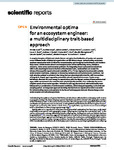Environmental optima for an ecosystem engineer: a multidisciplinary trait-based approach
| dc.contributor.author | Curd, A | |
| dc.contributor.author | Boyé, A | |
| dc.contributor.author | Cordier, C | |
| dc.contributor.author | Pernet, F | |
| dc.contributor.author | Firth, Louise | |
| dc.contributor.author | Bush, LE | |
| dc.contributor.author | Davies, AJ | |
| dc.contributor.author | Lima, FP | |
| dc.contributor.author | Meneghesso, C | |
| dc.contributor.author | Quéré, C | |
| dc.contributor.author | Seabra, R | |
| dc.contributor.author | Vasquez, M | |
| dc.contributor.author | Dubois, SF | |
| dc.date.accessioned | 2022-01-18T13:33:21Z | |
| dc.date.available | 2022-01-18T13:33:21Z | |
| dc.date.issued | 2021-11-26 | |
| dc.identifier.issn | 2045-2322 | |
| dc.identifier.issn | 2045-2322 | |
| dc.identifier.other | 22986 | |
| dc.identifier.uri | http://hdl.handle.net/10026.1/18577 | |
| dc.description.abstract |
<jats:title>Abstract</jats:title><jats:p>A complex interplay of biotic and abiotic factors underpins the distribution of species and operates across different levels of biological organization and life history stages. Understanding ecosystem engineer reproductive traits is critical for comprehending and managing the biodiversity-rich habitats they create. Little is known about how the reproduction of the reef-forming worm, <jats:italic>Sabellaria alveolata</jats:italic>, varies across environmental gradients. By integrating broad-scale environmental data with in-situ physiological data in the form of biochemical traits, we identified and ranked the drivers of intraspecific reproductive trait variability (ITV). ITV was highest in locations with variable environmental conditions, subjected to fluctuating temperature and hydrodynamic conditions. Our trait selection pointed to poleward sites being the most physiologically stressful, with low numbers of irregularly shaped eggs suggesting potentially reduced reproductive success. Centre-range individuals allocated the most energy to reproduction, with the highest number of intermediate-sized eggs, whilst equatorward sites were the least physiologically stressful, thus confirming the warm-adapted nature of our model organism. Variation in total egg diameter and relative fecundity were influenced by a combination of environmental conditions, which changed depending on the trait and sampling period. An integrated approach involving biochemical and reproductive traits is essential for understanding macro-scale patterns in the face of anthropogenic-induced climate change across environmental and latitudinal gradients.</jats:p> | |
| dc.format.extent | 22986- | |
| dc.format.medium | Electronic | |
| dc.language | en | |
| dc.language.iso | en | |
| dc.publisher | Nature Research | |
| dc.subject | Adaptation, Physiological | |
| dc.subject | Animals | |
| dc.subject | Biodiversity | |
| dc.subject | Climate Change | |
| dc.subject | Ecosystem | |
| dc.subject | Fertility | |
| dc.subject | Ovum | |
| dc.subject | Phenotype | |
| dc.subject | Polychaeta | |
| dc.subject | Reproduction | |
| dc.title | Environmental optima for an ecosystem engineer: a multidisciplinary trait-based approach | |
| dc.type | journal-article | |
| dc.type | Journal Article | |
| dc.type | Research Support, Non-U.S. Gov't | |
| plymouth.author-url | https://www.ncbi.nlm.nih.gov/pubmed/34837006 | |
| plymouth.issue | 1 | |
| plymouth.volume | 11 | |
| plymouth.publication-status | Published online | |
| plymouth.journal | Scientific Reports | |
| dc.identifier.doi | 10.1038/s41598-021-02351-7 | |
| plymouth.organisational-group | /Plymouth | |
| plymouth.organisational-group | /Plymouth/Faculty of Science and Engineering | |
| plymouth.organisational-group | /Plymouth/Faculty of Science and Engineering/School of Biological and Marine Sciences | |
| plymouth.organisational-group | /Plymouth/REF 2021 Researchers by UoA | |
| plymouth.organisational-group | /Plymouth/REF 2021 Researchers by UoA/UoA07 Earth Systems and Environmental Sciences | |
| plymouth.organisational-group | /Plymouth/Users by role | |
| plymouth.organisational-group | /Plymouth/Users by role/Academics | |
| dc.publisher.place | England | |
| dcterms.dateAccepted | 2021-10-26 | |
| dc.rights.embargodate | 2022-1-19 | |
| dc.identifier.eissn | 2045-2322 | |
| dc.rights.embargoperiod | Not known | |
| rioxxterms.versionofrecord | 10.1038/s41598-021-02351-7 | |
| rioxxterms.licenseref.uri | http://www.rioxx.net/licenses/all-rights-reserved | |
| rioxxterms.licenseref.startdate | 2021-11-26 | |
| rioxxterms.type | Journal Article/Review |


